South America Data Center Server Market Size
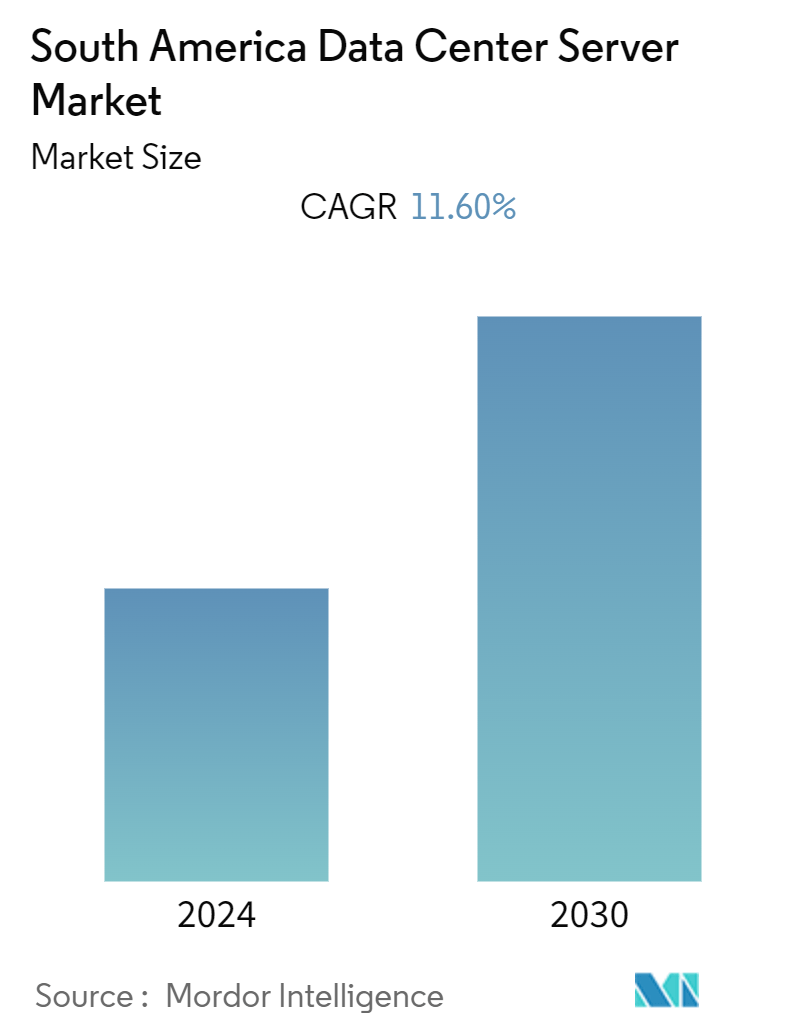
| Study Period | 2019 - 2030 |
| Base Year For Estimation | 2023 |
| Forecast Data Period | 2024 - 2030 |
| Historical Data Period | 2019 - 2022 |
| CAGR (2024 - 2030) | 11.60 % |
| Market Concentration | Medium |
Major Players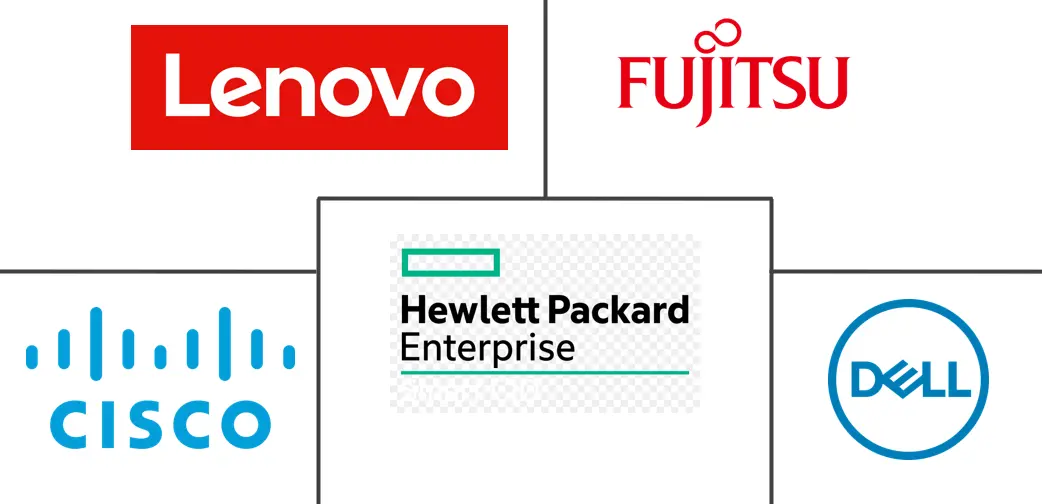
*Disclaimer: Major Players sorted in no particular order |
South America Data Center Server Market Analysis
The South America Data Center Server Market is expected to register a CAGR of 11.60% during the forecast period.
The South America data center server market reached a value of USD 3.2 billion in the previous year, and it is further projected to register a CAGR of 11.6% during the forecast period. The increasing demand for cloud computing among small and medium-sized enterprises (SMEs), government regulations for local data security, and growing investment by domestic players are some of the major factors driving the demand for data centers in the region.
- The upcoming IT load capacity of the South America data center construction market is expected to reach 1800 MW by 2029.
- The region's construction of raised floor area is expected to increase 7.8 million sq. ft by 2029.
- The region's total number of racks to be installed is expected to reach 392K units by 2029. Brazil is expected to house the maximum number of racks by 2029.
- There are close to 60 submarine cable systems connecting South America, and many are under construction. One such submarine cable that is estimated to start service in 2025 is Carnival Submarine Network-1 (CSN-1), which stretches over 4500 Kilometers with a landing point in Barranquilla, Colombia.
South America Data Center Server Market Trends
IT & Telecommunication Segment Holds The Major Share.
- Cloud service providers are the main contributors to South America's data center storage market. Expanding cloud presence through establishing multiple cloud regions across countries like Brazil, Chile, Colombia, and Argentina is expected to drive high-performance storage adoption in the market.
- Around 25% of large enterprises in Brazil have adopted artificial intelligence (AI) and machine learning technologies, contributing to the strong growth of high-performance storage systems in the market. Software-as-a-service (SaaS) was the leading business model of Brazilian startups, accounting for more than 41% of emerging companies in the country. With platform-as-a-service (PaaS) and infrastructure-as-a-service (IaaS), SaaS is one of Brazil's three principal categories of cloud computing.
- In Argentina, the evolution of the legal and regulatory environment for cloud computing has been faster and more in line with recent technological developments compared to other regional countries. Recently, Amazon Web Services announced plans to invest approximately USD 800 million over a decade in a new data center in Argentina.
- Many data centers run by well-known companies, like Google, Century Link, Huawei, and HP, and regional telcos Entel and Gtd are already located in Chile. These companies have taken advantage of the expanding demand from an increasingly technological corporate sector migrating to the cloud. As more players enter, Colombia is emerging as the next major South American market. Huawei targets a dedicated physical location for its cloud infrastructure and is expecting to activate a new cloud point-of-presence (PoP) in Colombia.
- The Argentine government is implementing a 'cloud first' policy by investing in and developing a robust national data center at ARSAT.
- In the telecom end-user segment of the South American data center market, Latin America and the Caribbean are expected to have 398 million 5G connections by 2027, which result in more data consumption in the coming years. All municipalities with at least 200,000 residents in Brazil are expected to have a 5G network by July 2026, with at least one antenna. Brazil's 5G spectrum auction held in October 2021 raised about USD 8.5 billion. By 2035, introducing 5G in Brazil may have a USD 1.2 trillion economic impact and a USD 3 trillion productivity boost. Around 10% of network connections are expected to be 5G in South America by 2025. Thus, the above instances result in increased demand for space in data centers and, consequently, the need for more servers within data centers.
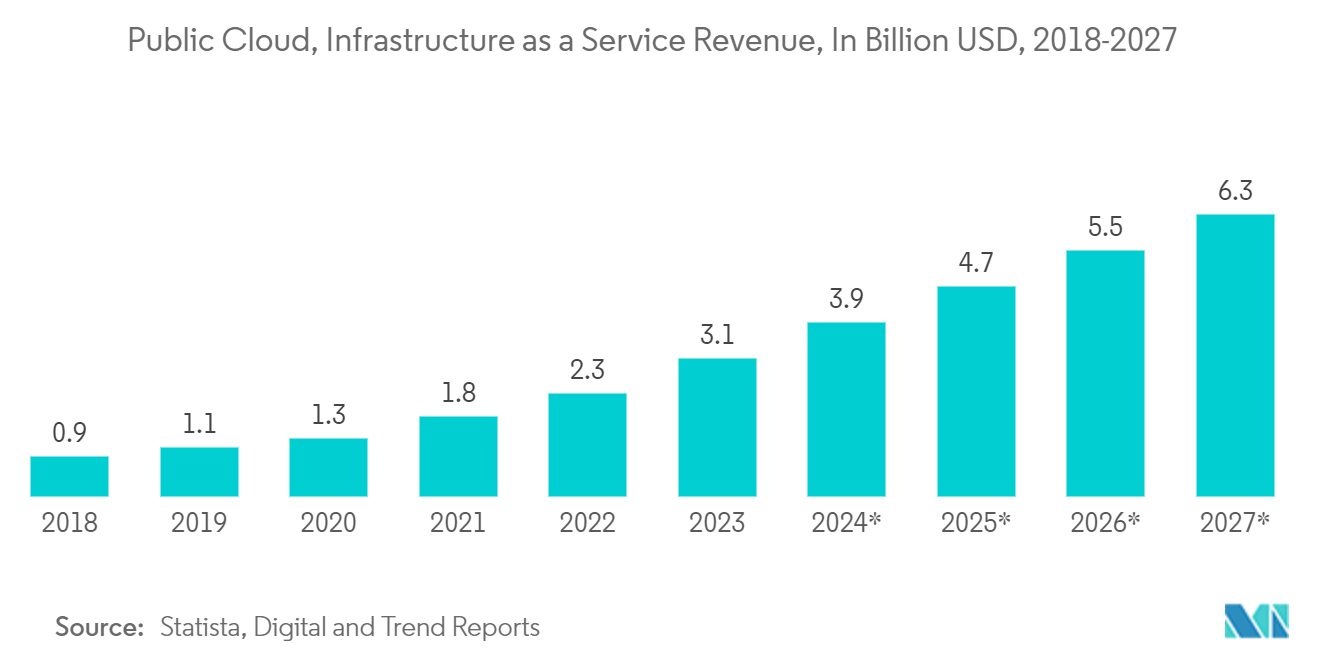
Brazil Holds The Major Share And Is Expected To Continue The Dominance During The Study Period.
- Brazil holds the largest share of the South American data center market. The Brazilian government provides incentives through the Regime Especial de Tributacao do Programa Nacional de Banda Larga (REPNBL) program, which includes incentives for purchasing infrastructure that helps improve colocation services in the country.
- Further, factors such as increasing internet penetration and digital payments, growing e-commerce sales and others driving the demand for data storage and processing have increased, which resulted in creating more need for data center servers in the region.
- For instance, in July 2022, 5G technology in the prime 3.5 GHz band was launched in Brazil with the activation of hundreds of antennas by three national operators in the capital, Brasilia. Activating a 5G 3.5 GHz standalone (SA) network, that is, not relying on existing bands or transmission equipment, was made possible after the technical liberation of the frequency in the capital. Under regulator Anatel's rules, all 26 state capitals were supposed to have commercial 5G in the 3.5GHz band activated by the end of September 2022. The adoption rate of the total connections is expected to grow from 1% to 11% by 2025.
- The State of Sao Paulo is expected to advance its digital transformation process to improve the quality and efficiency of public services to citizens, with a USD 164 million loan approved by the Inter-American Development Bank (IDB). Beyond successful startups, access to capital is one of the city's strengths: Brazilian startups raised a record USD 9.43 billion in 2021, 165.63% more than in 2020. Sao Paulo has 2,677 startups active in 34 sectors, and of these, 70% are concentrated in the capital, which may lead to major growth in the massive and large data size construction.
- Furthermore, In January 2023, Brazilian telecom services company Telecall announced plans to expand its fiber optics network to interconnect the primary data centers in Rio de Janeiro. The three new redundant and underground fiber routes, totaling 80 km, will be deployed by Telecall to connect at least four new data centers installed in Rio de Janeiro. Overall, Brazil is a major hub for data center locations. Such investments across the country increase demand for space in data centers and, consequently, the need for more servers within data centers in the coming years.
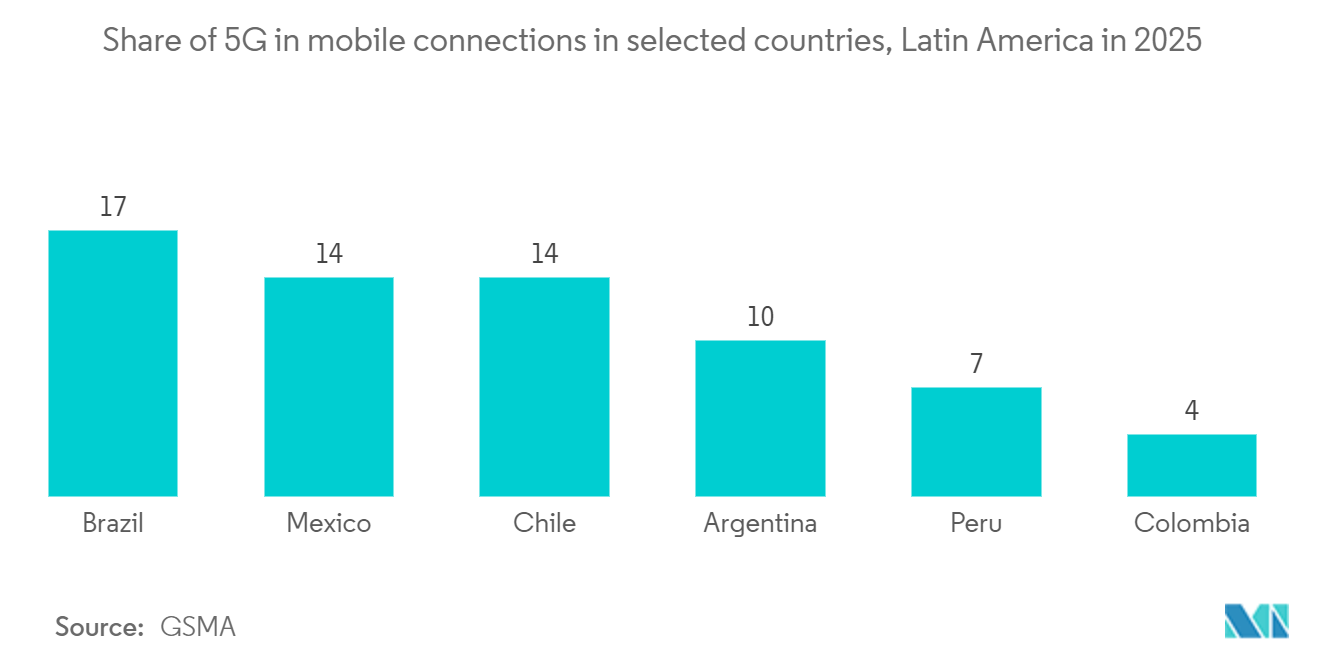
South America Data Center Server Industry Overview
The upcoming DC construction projects in the region will increase the demand for data center servers in the coming years. The South America data center server market is moderately consolidated with a few major players, such as Dell Inc., Hewlett Packard Enterprise, Fujitsu, and Lenovo Group Limited. These major players, with a prominent market share, focus on expanding their regional customer base.
In August 2023, Dell Inc. is transitioning its servers with Next-generation Dell PowerEdge Servers from OSA to ESA with PowerEdge R760 powered by 4th generation Intel Xeon Processors.
In January 2023, Cisco announced the launch of the 7th generation of UCS C-Series and X-Series servers, powered by 4th generation Intel Xeon Scalable processors. With support for the latest Intel processors, Cisco has launched two new blades for the X-Series: the Cisco UCS X210c M7 Compute Node and the Cisco UCS X410c M7 Compute Node.
South America Data Center Server Market Leaders
-
Dell Inc.
-
Hewlett Packard Enterprise
-
Lenovo Group Limited
-
Cisco Systems Inc.
-
IBM Corporation
*Disclaimer: Major Players sorted in no particular order
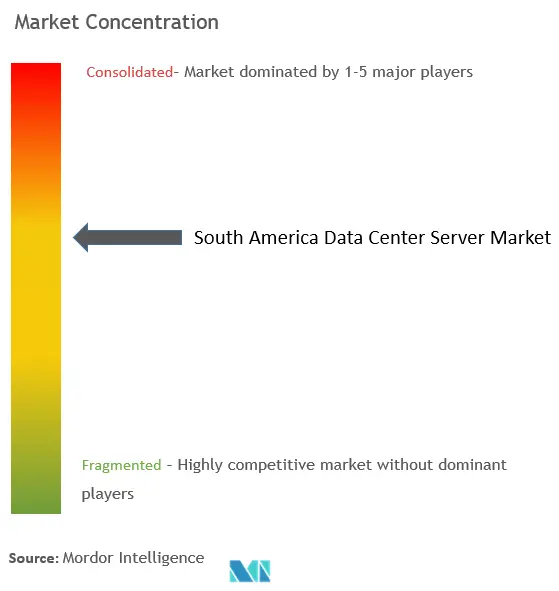
South America Data Center Server Market News
- January 2023: Supermicro announced the launch of its new server and storage portfolio with more than 15 families of performance-optimized systems focusing on cloud computing, AI, and HPC, as well as enterprise, media, and 5G/telco/edge workloads. SuperBlade would deliver the computational performance of a whole server rack in a considerably smaller physical footprint by using shared, redundant components, including cooling, networking, power, and chassis management. These blade server systems are geared for AI, Data Analytics, HPC, Cloud, and Enterprise applications and feature GPU-enabled blades.
- September 2022: Lenovo Group Ltd. introduced dozens of new servers, storage systems, and Hyperconverged Infrastructure appliances, as well as a cloud-based hardware management service. Intel Corp. Sapphire Rapids server processors would be incorporated into some of the new systems it is rolling out. The processors, which are scheduled to launch in the market next year, use a ten-nanometer Intel 7 manufacturing process.
South America Data Center Server Market Report - Table of Contents
1. INTRODUCTION
- 1.1 Study Assumption & Market Definition
- 1.2 Scope of the Study
2. Research Methodology
3. Executive Summary
4. Market Dynamics
- 4.1 Market Overview
-
4.2 Market Drivers
- 4.2.1 Increasing Adoption of Cloud Technologies
- 4.2.2 Large-scale commercialization of 5G networks
-
4.3 Market Restraints
- 4.3.1 Rising CapEx for data center construction
- 4.3.2 Cybersecurity Threats
- 4.4 Value Chain / Supply Chain Analysis
-
4.5 Industry Attractiveness - Porter's Five Forces Analysis
- 4.5.1 Threat of New Entrants
- 4.5.2 Bargaining Power of Buyers/Consumers
- 4.5.3 Bargaining Power of Suppliers
- 4.5.4 Threat of Substitute Products
- 4.5.5 Intensity of Competitive Rivalry
- 4.6 Assessment of COVID-19 Impact
5. MARKET SEGMENTATION
-
5.1 Form Factor
- 5.1.1 Blade Server
- 5.1.2 Rack Server
- 5.1.3 Tower Server
-
5.2 End-User
- 5.2.1 IT & Telecommunication
- 5.2.2 BFSI
- 5.2.3 Government
- 5.2.4 Media & Entertainment
- 5.2.5 Other End-User
-
5.3 Geography
- 5.3.1 Brazil
- 5.3.2 Chile
- 5.3.3 Rest of South America
6. COMPETITIVE LANDSCAPE
-
6.1 Company Profiles
- 6.1.1 Dell Inc.
- 6.1.2 Hewlett Packard Enterprise
- 6.1.3 Lenovo Group Limited
- 6.1.4 Fujitsu Limited
- 6.1.5 Cisco Systems Inc.
- 6.1.6 Kingston Technology Company Inc.
- 6.1.7 Huawei Technologies Co. Ltd.
- 6.1.8 Inspur Group
- 6.1.9 International Business Machines (IBM) Corporation
- *List Not Exhaustive
7. INVESTMENT ANALYSIS
8. MARKET OPPORTUNITIES AND FUTURE TRENDS
** Subject To AvailablitySouth America Data Center Server Industry Segmentation
A data center server is basically a high-capacity computer without peripherals like monitors and keyboards. It is a hardware unit installed inside a rack, having a central processing unit (CPU), storage, and other electrical and networking equipment, making them powerful computers that deliver applications, services, and data to end-user devices.
The South America data center server market is segmented by form factor (blade server, rack server, and tower server), by end-user (IT and telecommunication, BFSI, government, media and entertainment, and other end users), and by geography (Brazil, Chile, and Rest of South America). The market sizes and forecasts are provided in terms of value (USD) for all the above segments.
| Form Factor | Blade Server |
| Rack Server | |
| Tower Server | |
| End-User | IT & Telecommunication |
| BFSI | |
| Government | |
| Media & Entertainment | |
| Other End-User | |
| Geography | Brazil |
| Chile | |
| Rest of South America |
South America Data Center Server Market Research Faqs
What is the current South America Data Center Server Market size?
The South America Data Center Server Market is projected to register a CAGR of 11.60% during the forecast period (2024-2030)
Who are the key players in South America Data Center Server Market?
Dell Inc., Hewlett Packard Enterprise, Lenovo Group Limited, Cisco Systems Inc. and IBM Corporation are the major companies operating in the South America Data Center Server Market.
What years does this South America Data Center Server Market cover?
The report covers the South America Data Center Server Market historical market size for years: 2019, 2020, 2021, 2022 and 2023. The report also forecasts the South America Data Center Server Market size for years: 2024, 2025, 2026, 2027, 2028, 2029 and 2030.
South America Data Center Server Industry Report
Statistics for the 2024 South America Data Center Server market share, size and revenue growth rate, created by Mordor Intelligence™ Industry Reports. South America Data Center Server analysis includes a market forecast outlook to for 2024 to 2030 and historical overview. Get a sample of this industry analysis as a free report PDF download.



